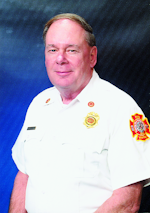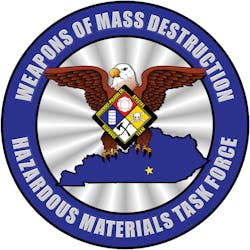Hazmat Studies: Meet Kentucky's All-Volunteer Somerset/Pulaski County SRT
Somerset is situated in south-central Kentucky on the northeastern edge of Lake Cumberland, 76 miles south of Lexington, 128 miles southeast of Louisville and 129 northwest of Knoxville, TN, and is the county seat of Pulaski County. Somerset measures eight square miles and has a population of 11,196. Pulaski County is the second-largest county in Kentucky and covers a land area of 653 square miles and has a population of 54,570.
The Somerset/Pulaski County Special Response Team (SRT) was formed in 2000. Pulaski County had a small hazmat team prior to 2000, but it was disbanded in 1998 due to lack of funding. Original members of the team went to county government to seek funding for the new SRT. Jeff Marcum was the first chief and was replaced by Doug Baker in 2001, who has remained the chief since that time. In addition to Baker, the command staff is comprised of an assistant chief who serves as entry sector commander, a major who serves as operations sector commander, two captains who handle logistics and medical and six lieutenants. All officers are cross-trained in all areas of command and operations.
Somerset’s SRT is a standalone weapons of mass destruction (WMD)/hazardous materials team that has no other duties. All personnel, including officers, are volunteers and receive no monetary compensation for their services. It is the only such standalone team in Kentucky. In addition to being standalone, the SRT is relatively autonomous in terms of outside oversight, although it receives input from the Pulaski County Department of Public Safety.
Initially, the team was funded by Pulaski County as a member of the Pulaski County Fire Commission. In 2002, Kentucky Emergency Management initiated a regional response system with 16 regional teams (only three of these original teams remain in service; the others are the Blue Grass Emergency Response Team and a northern Kentucky team based in of Alexandria, both based out of fire departments in those areas). The original state-sponsored teams were funded by the federal Department of Homeland Security (DHS) for equipment.
Somerset/Pulaski SRT was chosen to be the host team for the 10 County Rapid Response Team and designated as Hazmat 12. Hazmat 12 is governed by a board of directors with one representative from each of the 10 counties. The representatives then elect a board chairman, currently Tiger Robinson from the Pulaski County Department of Public Safety. They cover an area of 3800 square miles with a population of 211,000. Team members are made up of firefighters, law enforcement, former military personnel, paramedics and two members of the Kentucky National Guard's 41st Civil Support Team based in Louisville, Kentucky. They have been in service for 13 years without an injury to any personnel.
The SRT is housed in its own 10,000-square-foot facility in Somerset. Apparatus-related space takes up about 7,000 square feet of the building and there is 3,000 square feet of training space. The SRT has 52 members in Pulaski County, with 45 trained to a minimum of the technician level. The minimum level of training for support personnel is the Operations Level. Personnel have taken additional specialty courses in radiation and response to chemical, ordnance/explosive, biological, and radiological/nuclear (COBRA) incidents at the Center for Domestic Preparedness in Aniston, AL.
Hazmat 12 has a total of 160 personnel based in the 10-county response area. All team members are put through an extensive background check, including fingerprinting. In the event mutual aid is required, approximately 12 technicians are available from the Somerset Fire Department, which has 24 paid personnel. Outside Somerset, mutual aid is available from Adair and Boyle counties. Mutual aid personnel are assigned to decontamination.
Apparatus housed at the WMD/hazmat station include:
• Hazmat 2 is a 1992 Spartan/Supervac rescue (a reserve apparatus) that carries decontamination equipment and personal protective equipment (PPE); this unit is available to be used by Somerset Fire Department technicians for response to an incident in within Pulaski County in the event the Pulaski County SRT is out of the area on a response as Hazmat 12
• Hazmat 3 is a 2002-2012 E-ONE Cyclone II rescue that carries all primary hazmat and WMD response equipment, including instrumentation and PPE
• Hazmat 7 is a 2005 E-ONE walk-in rescue for decontamination and testing equipment
• Hazmat 4 is a 1997 International/Hackney rescue that carries decontamination equipment
• Hazmat 9 is a 2003 Ford E350 used for rehab
• Hazmat 1 is a 2009 Chevy Suburban command and communications unit equipped for satellite communications
• Kawasaki Mule for entry-team transport downrange
• 16-foot barrel trailer for spills
• 28-foot rehab and mule transport trailer
• 28-foot mass-decontamination shower trailer
• 18-foot equipment trailer
• 24-foot command and rehab trailer
• 4,000-watt light pod for night operations
All of the above units are SRT units that also respond as Hazmat 12 in the regional response system. Additionally, two units that are part of Hazmat 12 are stationed in Adair and Boyle counties. They are 2003 Ford F-250s with fully equipped Level A trailers.
Personnel protective equipment carried by the Somerset SRT includes MSA Nightstalker CBRN self-contained breathing apparatus (SCBA). Other breathing protection is both MSA and Scott cartridge respirators. Level A protective clothing is Dupont Tychem with flashover protection. Level B is also Dupont Tychem suits. Tychem coveralls with attached hoods and boots are available as well. Tingley hazmat boots and Petzl Vertex hardhats round out the protective suit ensemble. In-suit communications is accomplished with two-way radios. Chemical research is primarily conducted using the Internet.
Monitoring instruments carried by the SRT include: First Defender mass spectrometer; Smith Detection Hazmat and Gas ID; Drager manual and auto gas detection kits; HAZMATCAD chemical agent detector; Ludlum survey meter; Sensit gold CGI; HAZCAT chemical identification kit; Golden Engineering portable x-ray machine; and Raytek Raynger ST pro thermal laser.
Hazmat exposures in the SRT response area include the Norfolk Southern Railroad, U.S. Highway 27 and U.S. Highway 80. Fixed-facility hazards are present in chlorine at water treatment plants, propane, pesticides and a plant where large quantities of ammonium nitrate fertilizer are stored. Hazmat 12 is also a backup for the counties involved in the Chemical Stockpile Emergency Preparedness Program for the Blue Grass Arsenal, where military chemical agents are stored. They would cover south and west evacuation routes in the event of a release of chemical agent at the Blue Grass Arsenal.
The Somerset Fire Department responds to fuel spills and odor complaints within the city. Units carry small amounts of absorbent materials and handle spills up to 25 gallons of gasoline and 50 gallons of diesel fuel. The SRT is called in for larger spills. SRT responds to an average of 15 to 20 large-scale hazmat and WMD incidents per year.
Several major incidents have occurred over the past few years. Sodium hydroxide was spilled on U.S. Highway 27 in McCreary County on April 4, 2013 when a tractor-trailer rolled over into the ditch line. Initially, only eight to 10 gallons of sodium hydroxide were spilled. Hazmat crews established a decontamination corridor and ordered 10 truckloads of dirt to build a dike in the event the trailer of sodium hydroxide were to rupture during off loading. This would keep the sodium hydroxide out of nearby streams downhill from the incident. These preparations would prove to be invaluable as the incident progressed.
Around midnight, the damaged tanker ruptured, emptying between 2,800 and 3,000 gallons of sodium hydroxide. Two clean-up workers were covered with the caustic chemical and had to be decontaminated and rushed to a local hospital. They were wearing protective clothing, but sustained facial burns and vision problems. After almost 24 hours on scene, crews completed mitigation of the spill, which included removing contaminated soil and reopening the highway.
For questions and additional information, contact Chief Doug Baker at 606-305-3892 or Assistant Chief Dan Karriker at 606-305-5834. The mailing address is P.O. Box 1043, Somerset, KY 42502.
ROBERT BURKE, hazardous materials and fire protection consultant, a Firehouse® contributing editor, is a Certified Fire Protection Specialist (CFSP), Fire Inspector II, Fire Inspector III, Fire Investigator and Hazardous Materials Specialist, and has served on state and county hazmat teams. Burke is the author of the textbooks Hazardous Materials Chemistry for Emergency Responders, Counter-Terrorism for Emergency Responders, Fire Protection: Systems and Response and Hazmat Teams Across America. He can be contacted at [email protected].

Robert Burke
Robert Burke, who is a hazardous materials and fire protection consultant and who served as a Firehouse contributing editor, is a Certified Fire Protection Specialist (CFSP), Fire Inspector II, Fire Inspector III, Fire Investigator and Hazardous Materials Specialist. He has served on state and county hazmat teams. Burke is the author of the textbooks "Hazardous Materials Chemistry for Emergency Responders," "Counter-Terrorism for Emergency Responders," "Fire Protection: Systems and Response," "Hazmat Teams Across America" and "Hazmatology: The Science of Hazardous Materials."






